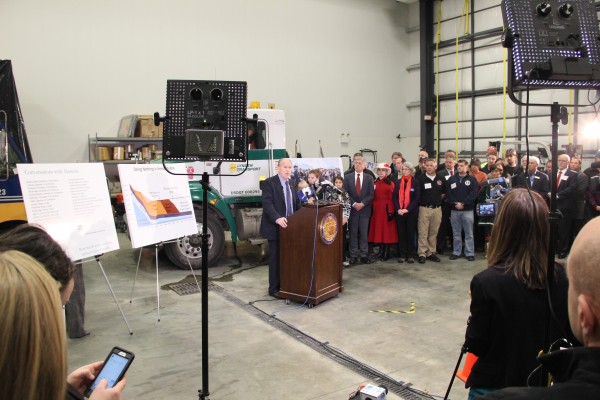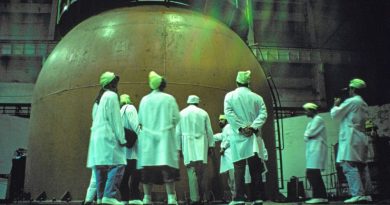Major changes to oil tax credits in Alaska budget

Alaska Governor Bill Walker’s budget proposal, rolled out last week, includes taxes on everything from fishing, mining and tourism to gasoline, alcohol and tobacco; plus, of course, Alaska’s first income tax in 35 years.
It also includes cuts to popular programs like home heating assistance, pre-K grants, winter road maintenance and, yes, the PFD.
As the governor himself said, there is plenty for everyone in Alaska to dislike.
But one reason the cuts aren’t deeper and the taxes aren’t steeper is because the governor’s budget also gets about half a billion dollars from the oil and gas industry. Walker is proposing deep cuts to the state’s system of oil and gas tax credits.
Here is the state’s problem, in two numbers:
$3.4 billion a year: that’s how much the state averaged in oil and gas production taxes over the last decade.
$180 million: that’s how much the state expects to collect next year.
That’s a 95 percent drop – mostly the result of plunging oil prices. And it’s the main culprit in the state’s three and a half billion dollar budget deficit.
Ken Alper is the director of the state Tax Division.
“Even if we didn’t want to change things, we can’t afford it,” he said.
And that’s essentially the governor’s position: something’s got to give.
Because here’s another number: $500 million. That’s about how much the state is paying out to oil and gas companies in refundable tax credits this year. Those credits are aimed at smaller companies. They’re designed to encourage new exploration and development. And they’ve worked, Alper said
“In some ways we’ve been successful,” he said. “But in some ways we’ve almost been too successful.”
Too successful, in that the state is now paying out more in tax credits to some companies than it takes in as production taxes from the whole industry.
It’s worth noting that the state does get other revenue from oil and gas — most important, royalties. But production taxes have historically been the main driver of the state budget.
The governor’s budget tries to fix what his administration sees as this imbalance. His plan has four main parts.
Part one: raise taxes
The plan would increase the minimum tax on oil and gas companies from four percent to five percent, and close a loophole that allows companies to use credits to dip beneath that four percent floor. Together, these changes would bring in about $100 million a year.
Part two: cut credits
Right now there are two main types of refundable credits: those based on your expenses. And those based on your losses. If a company, for example one of those drilling in Cook Inlet, stacks those credits, it can get reimbursed for, say, 65 percent of its costs.
Alper said that’s too much.
“Realistically we’ve encouraged a lot of folks to look at Alaska who might not have otherwise done so, simply by paying two thirds of their costs. That’s an extraordinary bonus,” he said. “So our feeling is, if we can just ratchet that down to an affordable number, if we’re paying one third of a company’s costs, we might get just as much bang for half as much buck.”
The governor’s plan would leave in place the credits for operating losses, estimated at about $100 million a year. But it would get rid of the credits for drilling and exploration – allowing some to expire in 2016, and repealing others.
The administration estimates that would save the state about $400 million next year.
Part three: the transition fund
If adopted, the governor’s plan wouldn’t take effect until July 2016, so the state would pay out any credits earned up to that date. The administration is proposing to set aside about $1 billion from state savings accounts to cover those costs.
Part four: the loan fund
In place of credits, the governor wants to offer low-cost loans. The administration would use about $200 million in state savings to endow a fund run by AIDEA, the Alaska Industrial Development and Export Authority.
The loans would be aimed at companies that came into the state recently, perhaps drawn by the credit program, and found oil and gas, but now need help getting over the hump into actual production.
“That means it’s going to cover a pad and road, or it’ll cover a well, or it’ll cover disposal facilities,” said Marcia Davis, deputy chief of staff to Walker. “It’ll cover a chunk of infrastructure.”
The loans wouldn’t be nearly enough to fund a whole project, Davis says. But the administration hopes it could complement private financing.
So, how has the plan been received by the industry?
“This is the number one thing on everyone’s radar,” said Kara Moriarty, president of the Alaska Oil and Gas Association. Moriarty said companies are already being battered by low oil prices, and if Alaska changes its tax regime yet again, it would hit the industry hard.
“I had one member say, you know, if the governor changes the tax system again, it is the fifth major tax change his company has experienced in ten years,” Moriarty said.
The big question, of course, is how this plan will fare with lawmakers, who will gather in Juneau next month.
Anchorage Republican Cathy Giessel chairs the Senate’s Natural Resources Committee — and she’s not thrilled with what she’s hearing.
Giessel argues that for every dollar the state pays out in credits, it will get back significantly more in royalties and economic activity down the line. But she does want to harden the minimum tax floor – though not raise it – and she agrees that maybe credits shouldn’t be stackable.
“There’s a discussion that I would be delighted to have,” Giessel said. “But that’s not throwing out the baby with the bath water, as has been verbalized [by the administration].”
Across the aisle, Senator Bill Wielechowski, an Anchorage Democrat, had a different baby-themed metaphor.
“Certainly it’s a step in the right direction, but it’s baby steps,” he said. “It’s like crawling.”
Wielechowski says the governor’s plan doesn’t go far enough. Among other changes, he wants to increase the minimum tax to more than 12 percent.
That idea probably won’t get far in the Republican-controlled legislature.
Whether the governor’s plan gets any farther, remains to be seen.
Related stories from around the North:
Finland: Finnish economy in a rut, 1.2% growth in 2016, Yle News
Iceland: Rejected by Iceland, billionaire sets sights on Arctic Finland for tourism project, Yle News
Norway: Peace and stability crucial for Arctic economy, Barents Observer
Russia: Finnish firms relying on Russian business face bankruptcy threat, Yle News
United States: What Shell’s decision means for Alaska economy, Alaska Dispatch News



